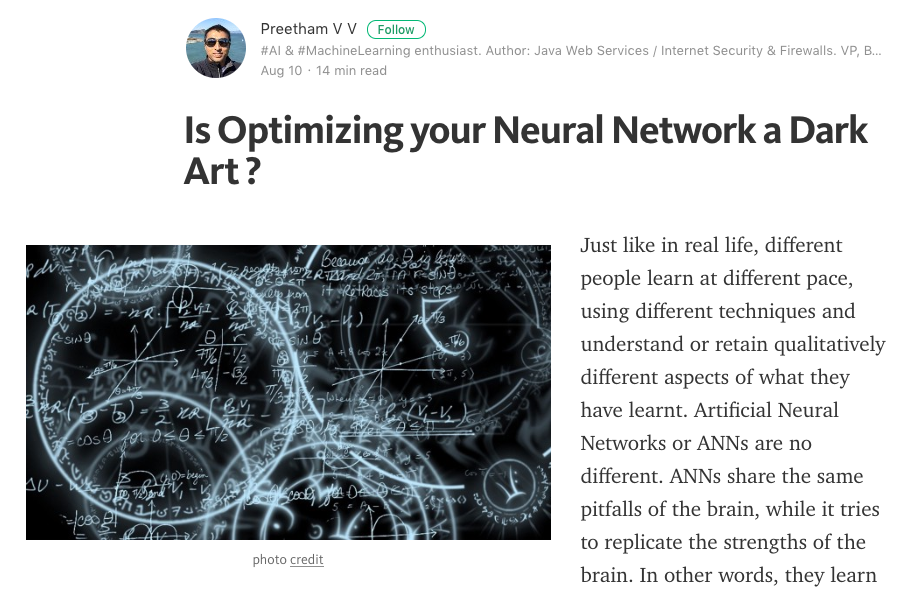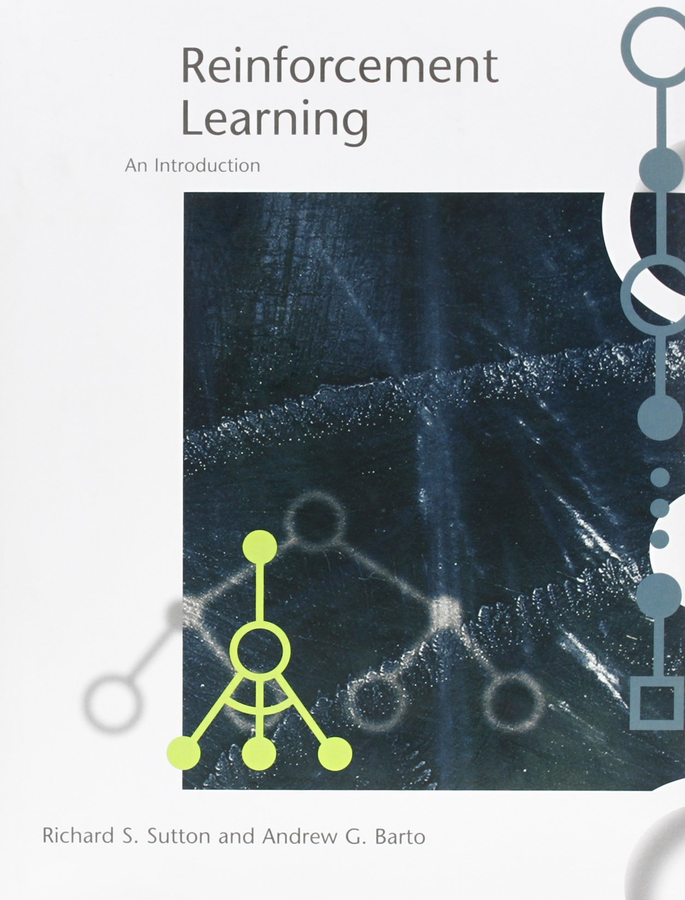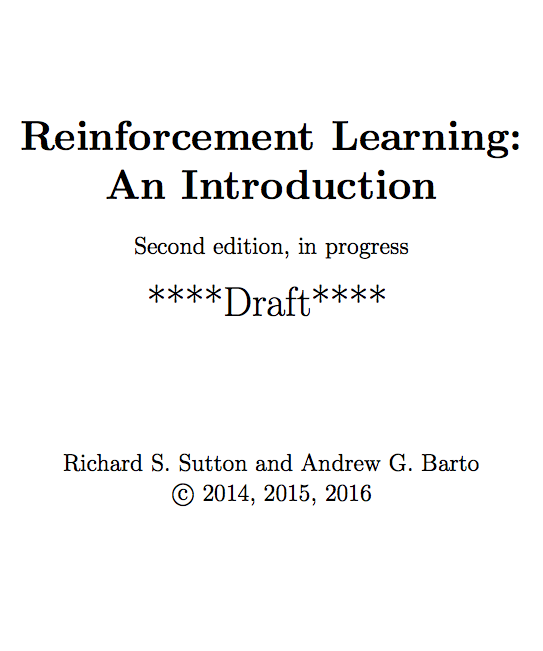



Machine Learning
Deep Learning and Reinforcement Learning


About Presenter Katharine Beaumont
Writer and editor for Voxxed, interviewer for Devoxx and Voxxed Days, developer for fun :-)
@KatharineCodes
Perpetual student, wandering into software development from maths, science, publishing, politics, law...


Developer / Mathematician / Writer / Speaker - Voxxed


About Presenter James Weaver
Java Champion, JavaOne Rockstar, plays well with others, etc :-)


@JavaFXpert
Author of several Java/JavaFX/RaspPi books

Developer Advocate & International Speaker for Pivotal
From introductory video in Machine Learning course (Stanford University & Coursera) taught by Andrew Ng.


@KatharineCodes @JavaFXpert


Self-driving cars
@KatharineCodes @JavaFXpert
Generating image descriptions


@KatharineCodes @JavaFXpert

Supervised Learning

@KatharineCodes @JavaFXpert
Supervised learning regression problem


@KatharineCodes @JavaFXpert

Unsupervised Learning

@KatharineCodes @JavaFXpert
Unsupervised learning finds structure in unlabeled data


(e.g. market segment discovery, and social network analysis)
@KatharineCodes @JavaFXpert

Reinforcement Learning

@KatharineCodes @JavaFXpert
AlphaGo is a recent reinforcement learning success story


@KatharineCodes @JavaFXpert

Supervised Learning

(Let's dive in now)
@KatharineCodes @JavaFXpert
Supervised learning classification problem

(using the Iris flower data set)


@KatharineCodes @JavaFXpert
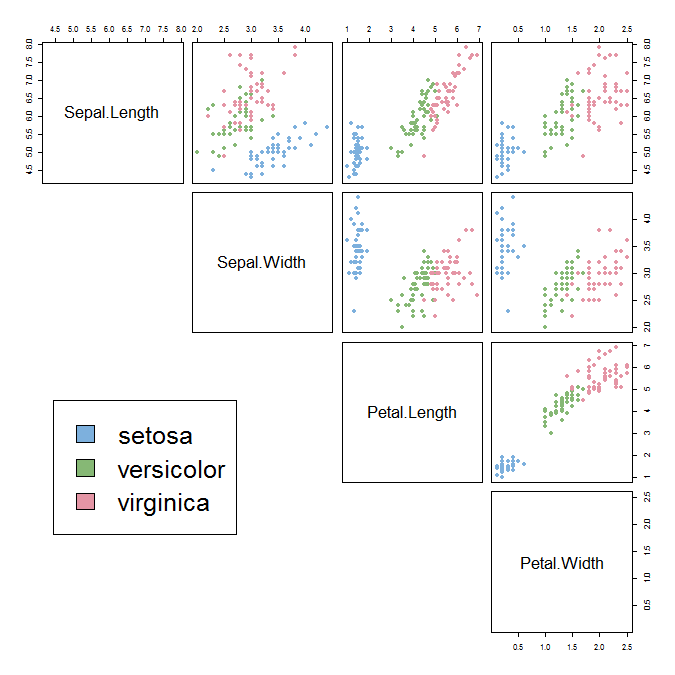


@KatharineCodes @JavaFXpert
Modeling the brain works well with machine learning
(ya think?)


(inputs)
(output)

@KatharineCodes @JavaFXpert
Neural net visualization app (uses Spring and DL4J)


@KatharineCodes @JavaFXpert
Entering feature values for prediction (classification)


@KatharineCodes @JavaFXpert













Anatomy of an Artificial Neural Network

(aka Deep Belief Network when multiple hidden layers)

@KatharineCodes @JavaFXpert
Simple neural network trained for XOR logic


forward propagation
@KatharineCodes @JavaFXpert
Feedforward calculations with XOR example

For each layer:

Multiply inputs by weights:
(1 x 8.54) + (0 x 8.55) = 8.54
Add bias:
8.54 + (-3.99) = 4.55
Use sigmoid activation function:
1 / (1 + e
-4.55
) = 0.99
@KatharineCodes @JavaFXpert



















Simple neural network trained for XOR logic


back propagation (minimize cost function)
@KatharineCodes @JavaFXpert
Back propagation

(Uses gradient descent to iteratively minimize the cost function)

@KatharineCodes @JavaFXpert






Great website for data science / machine learning enthusiasts


@KatharineCodes @JavaFXpert
Let’s use a dataset from kaggle.com to train a neural net on speed dating


@KatharineCodes @JavaFXpert
Identify features and label we’ll use in the model

Let’s use 65% of the 8378 rows for training and 35% for testing

@KatharineCodes @JavaFXpert
Code that configures our speed dating neural net



@KatharineCodes @JavaFXpert
Trying our new speed dating neural net example


In this example, all features are continuous, and output is a one-hot vector
@KatharineCodes @JavaFXpert
Making predictions with our speed dating neural net

Note that input layer neuron values are normalized

@KatharineCodes @JavaFXpert
Output from training Speed Dating dataset

In iterationDone(), iteration: 0, score: 0.8100 In iterationDone(), iteration: 20, score: 0.5991 In iterationDone(), iteration: 40, score: 0.5414 In iterationDone(), iteration: 60, score: 0.5223 In iterationDone(), iteration: 80, score: 0.5154 Examples labeled as 0 classified by model as 0: 1356 times Examples labeled as 0 classified by model as 1: 354 times Examples labeled as 1 classified by model as 0: 413 times Examples labeled as 1 classified by model as 1: 800 times ==========================Scores======================== Accuracy: 0.7351 Precision: 0.7269 Recall: 0.7239 F1 Score: 0.7254
@KatharineCodes @JavaFXpert
}














Is Optimizing your Neural Network a Dark Art ?

Excellent article by Preetham V V on neural networks and choosing hyperparameters
@KatharineCodes @JavaFXpert
Regression Sum example

Features are continuous values, output is continuous value

@KatharineCodes @JavaFXpert
Training a neural network to play Tic-Tac-Toe


@KatharineCodes @JavaFXpert
Tic-Tac-Toe neural network architecture



Input layer: 9 one-hot vectors (27 nodes)
- 1,0,0 (empty cell)
- 0,1,0 (X in cell)
- 0,0,1 (O in cell)
Hidden layer: 54 sigmoid neurons
Output layer: One-hot vector (9 nodes)
Client developed in JavaFX with Gluon mobile
0
0
0
0
0
1
1
1
1
0
0
0
0
0
0
0
0
1
0
/player?gameBoard=XXOOXIIOI
&strategy=neuralNetwork
"gameBoard": "XXOOXXIOI",
{
}
...
Java/Spring REST microservice
@KatharineCodes @JavaFXpert
Tic-Tac-Toe training dataset

0, 1,0,0, 1,0,0, 1,0,0, 1,0,0, 1,0,0, 1,0,0, 1,0,0, 1,0,0, 1,0,0
3, 0,1,0, 0,0,1, 1,0,0, 1,0,0, 1,0,0, 1,0,0, 1,0,0, 1,0,0, 1,0,0
3, 0,1,0, 1,0,0, 0,0,1, 1,0,0, 1,0,0, 1,0,0, 1,0,0, 1,0,0, 1,0,0
1, 0,1,0, 1,0,0, 1,0,0, 0,0,1, 1,0,0, 1,0,0, 1,0,0, 1,0,0, 1,0,0
1, 0,1,0, 1,0,0, 1,0,0, 1,0,0, 0,0,1, 1,0,0, 1,0,0, 1,0,0, 1,0,0
2, 0,1,0, 1,0,0, 1,0,0, 1,0,0, 1,0,0, 0,0,1, 1,0,0, 1,0,0, 1,0,0
1, 0,1,0, 1,0,0, 1,0,0, 1,0,0, 1,0,0, 1,0,0, 0,0,1, 1,0,0, 1,0,0
2, 0,1,0, 1,0,0, 1,0,0, 1,0,0, 1,0,0, 1,0,0, 1,0,0, 0,0,1, 1,0,0
2, 0,1,0, 1,0,0, 1,0,0, 1,0,0, 1,0,0, 1,0,0, 1,0,0, 1,0,0, 0,0,1
4, 0,1,0, 0,0,1, 1,0,0, 0,1,0, 1,0,0, 1,0,0, 0,0,1, 1,0,0, 1,0,0
...
Play cell
Game board cell states before play
Leveraging the neural network as a function approximator
@KatharineCodes @JavaFXpert
Tic-Tac-Toe training dataset

Generated using game theory minimax algorithm
https://github.com/JavaFXpert/tic-tac-toe-minimax written in Java by @RoyVanRijn using guidance from the excellent Tic Tac Toe: Understanding The Minimax Algorithm article by @jasonrobertfox
@KatharineCodes @JavaFXpert
Taking Tic-Tac-Toe for a spin


@KatharineCodes @JavaFXpert

Reinforcement Learning

(Let's dive in now)
@KatharineCodes @JavaFXpert
Using BURLAP for Reinforcement Learning


@KatharineCodes @JavaFXpert
Learning to Navigate a Grid World with Q-Learning


@KatharineCodes @JavaFXpert
Rules of this Grid World


- Agent may move left, right, up, or down (actions)
- Reward is 0 for each move
- Reward is 5 for reaching top right corner (terminal state)
- Agent can't move into a wall or off-grid
- Agent doesn't have a model of the grid world. It must discover as it interacts.
Challenge: Given that there is only one state that gives a reward, how can the agent work out what actions will get it to the reward?
(AKA the credit assignment problem)
Goal of an episode is to maximize total reward
@KatharineCodes @JavaFXpert
Visualizing training episodes


From BasicBehavior example in https://github.com/jmacglashan/burlap_examples
@KatharineCodes @JavaFXpert
This Grid World's MDP (Markov Decision Process)


In this example, all actions are deterministic
@KatharineCodes @JavaFXpert
Agent learns optimal policy from interactions with the environment (s, a, r, s')


@KatharineCodes @JavaFXpert
Q-Learning approach to reinforcement learning

| Left | Right | Up | Down | |
|---|---|---|---|---|
| ... | ||||
| 2, 7 | 2.65 | 4.05 | 0.00 | 3.20 |
| 2, 8 | 3.65 | 4.50 | 4.50 | 3.65 |
| 2, 9 | 4.05 | 5.00 | 5.00 | 4.05 |
| 2, 10 | 4.50 | 4.50 | 5.00 | 3.65 |
| ... |
Q-Learning table of expected values (cumulative discounted rewards) as a result of taking an action from a state and following an optimal policy. Here's an explanation of how calculations in a Q-Learning table are performed.
Actions
States
@KatharineCodes @JavaFXpert

Intuition and mathematics
[TODO: replace this slide with a set of slides that provide intuition and maths for filling in this Q-Learning table]
Q-Learning approach to reinforcement learning

@KatharineCodes @JavaFXpert
Expected future discounted rewards, and polices


@KatharineCodes @JavaFXpert
This example used discount factor 0.9


Low discount factors cause agent to prefer immediate rewards
@KatharineCodes @JavaFXpert


How often should the agent try new paths vs. greedily taking known paths?
@KatharineCodes @JavaFXpert
Tic-Tac-Toe with Reinforcement Learning

Learning to win from experience rather than by being trained

@KatharineCodes @JavaFXpert
Inspired by the Tic-Tac-Toe Example section...

@KatharineCodes @JavaFXpert
Tic-Tac-Toe Learning Agent and Environment


X
O
Our learning agent is the "X" player, receiving +5 for winning, -5 for losing, and -1 for each turn
The "O" player is part of the Environment. State and reward updates that it gives the Agent consider the "O" play.
@KatharineCodes @JavaFXpert
Tic-Tac-Toe state is the game board and status

| States | 0 | 1 | 2 | 3 | 4 | 5 | 6 | 7 | 8 |
|---|---|---|---|---|---|---|---|---|---|
| O I X I O X X I O, O won | N/A | N/A | N/A | N/A | N/A | N/A | N/A | N/A | N/A |
| I I I I I I O I X, in prog | 1.24 | 1.54 | 2.13 | 3.14 | 2.23 | 3.32 | N/A | 1.45 | N/A |
| I I O I I X O I X, in prog | 2.34 | 1.23 | N/A | 0.12 | 2.45 | N/A | N/A | 2.64 | N/A |
| I I O O X X O I X, in prog | +4.0 | -6.0 | N/A | N/A | N/A | N/A | N/A | -6.0 | N/A |
| X I O I I X O I X, X won | N/A | N/A | N/A | N/A | N/A | N/A | N/A | N/A | N/A |
| ... |
Q-Learning table of expected values (cumulative discounted rewards) as a result of taking an action from a state and following an optimal policy
Actions (Possible cells to play)
Unoccupied cell represented with an I in the States column
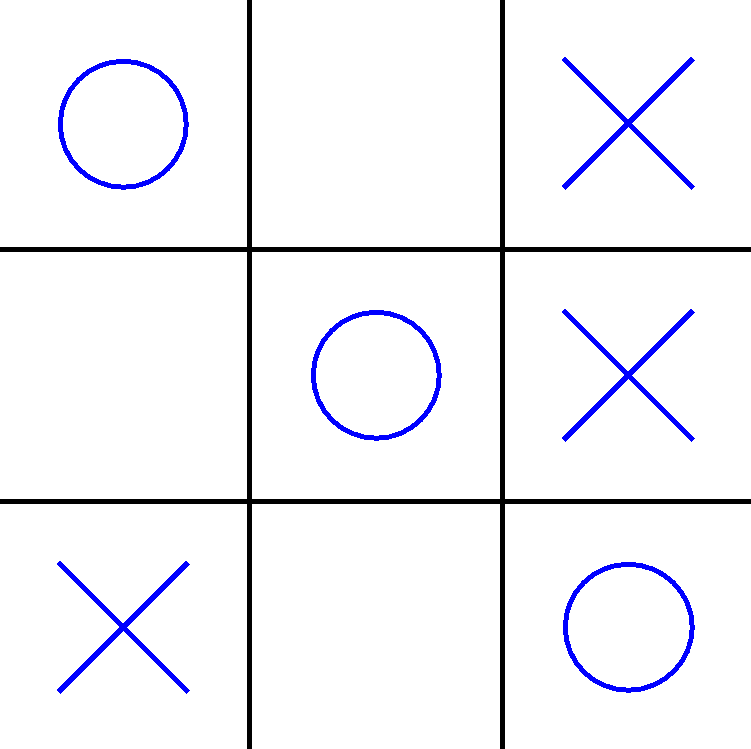
@KatharineCodes @JavaFXpert
Tic-Tac-Toe with Reinforcement Learning


@KatharineCodes @JavaFXpert
Summary of neural network links (1/2)

Andrew Ng video:
https://www.coursera.org/learn/machine-learning/lecture/zcAuT/welcome-to-machine-learning
Iris flower dataset:
https://en.wikipedia.org/wiki/Iris_flower_data_set
Visual neural net server:
http://github.com/JavaFXpert/visual-neural-net-server
Visual neural net client:
http://github.com/JavaFXpert/ng2-spring-websocket-client
Deep Learning for Java: http://deeplearning4j.org
Spring initializr: http://start.spring.io
Kaggle datasets: http://kaggle.com
@KatharineCodes @JavaFXpert
Summary of neural network links (2/2)

Tic-tac-toe client: https://github.com/JavaFXpert/tic-tac-toe-client
Gluon Mobile: http://gluonhq.com/products/mobile/
Tic-tac-toe REST service: https://github.com/JavaFXpert/tictactoe-player
Java app that generates tic-tac-toe training dataset:
https://github.com/JavaFXpert/tic-tac-toe-minimax
Understanding The Minimax Algorithm article:
http://neverstopbuilding.com/minimax
Optimizing neural networks article:
https://medium.com/autonomous-agents/is-optimizing-your-ann-a-dark-art-79dda77d103
A.I Duet application: http://aiexperiments.withgoogle.com/ai-duet/view/
@KatharineCodes @JavaFXpert
Summary of reinforcement learning links

BURLAP library: http://burlap.cs.brown.edu
BURLAP examples including BasicBehavior:
https://github.com/jmacglashan/burlap_examples
Markov Decision Process:
https://en.wikipedia.org/wiki/Markov_decision_process
Q-Learning table calculations: http://artint.info/html/ArtInt_265.html
Exploitation vs. exploration:
https://en.wikipedia.org/wiki/Multi-armed_bandit
Reinforcement Learning: An Introduction:
https://webdocs.cs.ualberta.ca/~sutton/book/bookdraft2016sep.pdf
Tic-tac-toe reinforcement learning app:
https://github.com/JavaFXpert/tic-tac-toe-rl
@KatharineCodes @JavaFXpert




Machine Learning
Deep Learning and Reinforcement Learning



